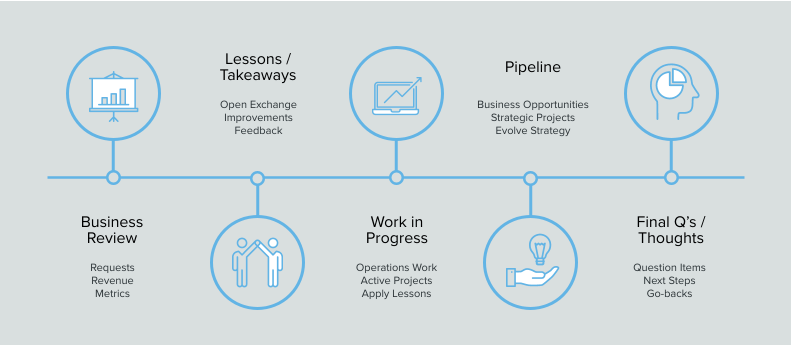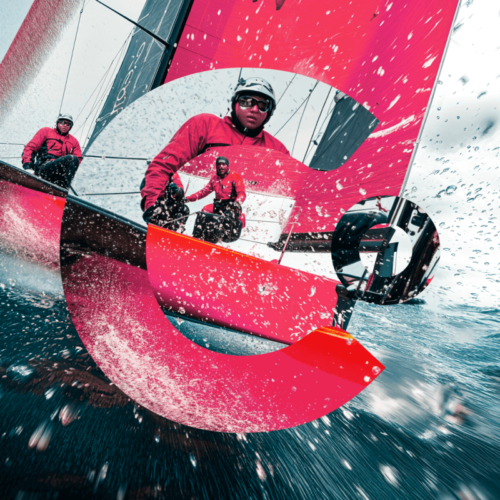There is a structure we typically follow to make sure we cover each key element, that communication remains open throughout, and that nothing is overlooked.
You’ve heard it before: You and your most valued partner company have been chugging along knocking down important work together, you hit a bump in the road, and someone says it: “It would have been nice if we had known that sooner.”
Part of this is just normal day-to-day communication breakdown with teams. It happens. Part of it is avoidable and, to help make sure we minimize it as much as we can, we’ve developed a partnership milestone we call our Quarterly Business Review (QBR).
The QBR has become a key ceremony in building and maintaining our most important and lasting client partnerships. It is a consistent opportunity for us not only to conduct a business review and discuss our recent projects, performance, and milestones, but it also empowers collaboration on the strategy, plans and goals for our work in the upcoming and subsequent quarters.
It gives all key members of the agency-client partnership team an opportunity to showcase their combined accomplishments and business improvements, and provides a structure where opportunities and takeaways are reviewed and discussed before work continues.
Who Should Attend a QBR Presentation
The most effective QBR includes senior leadership from both sides. From the client-side, this is usually the Chief Marketing Officer, Chief Digital Officer or Senior Vice President of Marketing.
A senior executive brings the all-important strategic view to the conversation, helps make sure the team goals remain in line with the company’s direction and can help quickly build momentum behind — and enthusiasm for — new initiatives. In return, client senior leaders get a polished strategic summary of the work the customer success team has completed, at a level of detail that’s often difficult to assemble, as well as the opportunity to ask questions and provide real-time feedback.

Preparing a Successful QBR
The setup for a successful QBR begins with — and is interwoven with — effective project and client support/maintenance planning across the entire partnership team. An effective team is aligned on how success is measured — including key performance indicators — and closely monitors progress as new opportunities are identified and rolled out.
Throughout the quarter, the partnership team is in regular communication about status and progress. A key element of this is making sure that everyone is aligned, and that goals are consistent with a detailed definition of customer success.
Quarterly Business Review Agenda
While each QBR meeting and presentation is unique and variable depending on the customer, company, industry, stakeholders, and specific projects, there is a structure we typically follow to make sure we cover each key element, that communication remains open throughout, and that nothing is overlooked.
The sessions themselves, depending on the discussion, typically range from two to four hours in duration.
1. The Business Review: We start with a thorough review of project progress over the past quarter, including detailed results, metrics highlights and revenue information, as applicable. Work requests are discussed, and key project and operational highlights are reviewed, while a partnership summary dashboard gives all attending the opportunity to quickly understand the volume and type of work completed.
The business review section concludes once questions are answered and discussion of quarterly accomplishments is complete.
2. Lessons Learned / Key Takeaways: While retrospectives are a part of the closure of every project, it’s important for the whole partnership team to look back and review what’s been learned and develop the key takeaways together. This is the focus of the second element of our QBR.
Both our agency team and the client team typically come to the table with ideas, and open exchange and feedback are encouraged. In this part of the meeting, the full team reviews and discusses what it did well, what it could improve upon, and any challenges that may interfere with taking the partnership to the next level.
Usually, a consensus around immediate next steps can be reached and is documented. In the case of more complex issues, additional meetings are scheduled to continue the discussion and identify how best to move forward.
3. Work in Progress: The third part of the QBR is a summary of active project and operations work, which gives the entire team the opportunity to better understand what’s happening. It also affords the team the opportunity to consider how it might apply the lessons learned and takeaways just developed to in-progress work.
4. The Pipeline: Next, in the fourth part of our QBR, work-in-progress discussions transition to a discussion of what’s on the horizon. The team reviews and discusses known strategic projects in the pipeline as well as potential business opportunities in the near, middle and long term. These discussions can not only lead to adjustments to active projects but are also important in helping the customer success team start thinking and getting excited about the evolving strategy.
5. Questions and Next Steps: In the last segment of the meeting, the team shares any final thoughts, discusses any remaining questions and go-backs, and reviews action items and next steps.

Putting QBR Findings into Action
Even the best QBR preparation and meeting won’t be successful if the customer success team never follows up on what it has discussed and decided, so we’ve learned it’s incredibly important to follow through promptly with a plan to build on the momentum created in the meeting.
We make sure that notes and action items are promptly distributed to all involved, that follow-up meetings are scheduled and held, and that the teams are reminded of discussions, commitments, lessons learned and takeaways between quarters.
The QBR has become a key ceremony in building and maintaining our most important and lasting client partnerships.
QBRs Foster a Collaborative Agency-Client Relationship
In the years we’ve been doing them, we’ve learned that our QBRs are a foundational element to our longest-lasting and most successful partnerships with our clients. It has helped us build an important cadence to our customer success process, where we match business reviews and metrics with roadmap and strategy. We make sure we have an open dialogue about what’s working well and what challenges the team may face.
The QBR represents an opportunity for the whole team to communicate, celebrate, plan and improve in a consistent structure that we’ve found helps build both morale and effectiveness over the long term.






